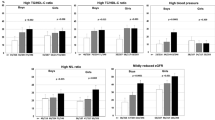Abstract
The increase in prevalence of obesity in childhood and adolescence appears to be followed by a rise of type 2 diabetes (T2D) cases in youth. Studies from the United States indicated that more than 1 in 10 adolescents may have disturbed glucose metabolism and that ethnicity and socioeconomic status are major determinants of (pre) diabetes prevalence. Since data for European countries are rare, we conducted a cross-sectional survey in 721 school-leaving boys and girls (mean age 15.5 years) in Düsseldorf (Germany). In our population from a predominantly low socioeconomic background, a total of 2.5% had impaired fasting glucose, impaired glucose tolerance or T2D. Hence, our study does not confirm the alarming data from high-risk US. American populations, but, nevertheless provides evidence for the necessity of public health interventions aiming at primary prevention of obesity and T2D in children and adolescents.
This is a preview of subscription content, access via your institution
Access options
Subscribe to this journal
Receive 12 print issues and online access
$259.00 per year
only $21.58 per issue
Buy this article
- Purchase on Springer Link
- Instant access to full article PDF
Prices may be subject to local taxes which are calculated during checkout
Similar content being viewed by others
References
American Diabetes Association. Type 2 diabetes in children and adolescents. Diabetes Care 2000; 23: 381–389.
Alberti G, Zimmet P, Shaw J, Bloomgarden Z, Kaufman F, Silink M et al. Type 2 diabetes in the young, the evolving epidemic: the International Diabetes Federation consensus workshop. Diabetes Care 2004; 27: 1798–1811.
Bloomgarden ZT . Type 2 diabetes in the young: the evolving epidemic. Diabetes Care 2004; 27: 998–1010.
Duncan GE . Prevalence of diabetes and impaired fasting glucose levels among US adolescents: National Health and Nutrition Examination Survey, 1999–2002. Arch Pediatr Adolesc Med 2006; 160: 523–528.
Wardle J, Brodersen NH, Cole TJ, Jarvis MJ, Boniface DR . Development of adiposity in adolescence: five year longitudinal study of an ethnically and socioeconomically diverse sample of young people in Britain. BMJ 2006; 332: 1130–1135.
Ogden CL, Carroll MD, Curtin LR, McDowell MA, Tabak CJ, Flegal KM . Prevalence of overweight and obesity in the United States, 1999–2004. JAMA 2006; 295: 1549–1555.
Rathmann W, Haastert B, Icks A, Giani G, Holle R, Meisinger C et al. Sex differences in the associations of socioeconomic status with undiagnosed diabetes mellitus and impaired glucose tolerance in the elderly population: the KORA Survey 2000. Eur J Publ Health 2005; 15: 627–633.
Fagot-Campagna A, Pettitt DJ, Engelgau MM, Burrows NR, Geiss LS, Valdez R et al. Type 2 diabetes among North American children and adolescents: an epidemiologic review and a public health perspective. J Pediatr 2000; 136: 664–672.
The STOPP-T2D Prevention Study Group. Presence of diabetes risk factors in a large US eighth-grade cohort. Diabetes Care 2006; 29: 212–217.
Neu A, Feldhahn L, Ehehalt S, Hub R, Ranke MB . MODY und Typ-2-Diabetes bei Kindem und Jugendlichen – Häufigkeit und Versorgung. Erste flächendeckende Erhebung in Baden-Württemberg. Diabetes und Stoffwechsel 2005; 14 (Suppl): 119–120 (Abstract).
Kiess W, Bottner A, Raile K, Kapellen T, Muller G, Galler A et al. Type 2 diabetes mellitus in children and adolescents: a review from a European perspective. Horm Res 2003; 59 (Suppl 1): 77–84.
Kromeyer-Hauschild K, Wabitsch M, Kunze D, Geller F, Ziegler A, Geiß HC et al. Perzentile für den Body Mass Index für das Kindes- und Jugendalter unter Heranziehung verschiedener deutscher Stichproben. Monatsschrift Kinderheilkunde 2001; 149: 807–818.
World Health Organization. Definition, Diagnosis and Classification of Diabetes Mellitus and its Complications. Report of a WHO Consultation. Part 1 Diagnosis and Classification of Diabetes Mellitus. WHO Department of Noncommunicable Disease Surveillance: Geneva, 1999; 1–59.
Schober E, Holl RW, Grabert M, Thon A, Rami B, Kapellen T et al. Diabetes mellitus type 2 in childhood and adolescence in Germany and parts of Austria. Eur J Pediatr 2005; 164: 705–707.
Centers for Disease Control National Center for Health Statistics: 2000 CDC Growth Charts: United States. Available at http://www.cdc.gov/growthcharts.
Must A, Jacques PF, Dallal GE, Bajema CJ, Dietz WH . Long-term morbidity and mortality of overweight adolescents. A follow-up of the Harvard Growth Study of 1922 to 1935. N Engl J Med 1992; 327: 1350–1355.
Acknowledgements
We thank Dr Horst Winkler, Renate Bredahl and Erik Hahnloser from the Public Health Office in Düsseldorf for their support in conducting the study and Liljana Uebber (German Diabetes Center) for excellent technical assistance with autoantibody measurement. This work was supported by the German Federal Ministry of Health and Social Security and the Ministry of Science and Research of the State North-Rhine Westphalia.
Author information
Authors and Affiliations
Corresponding author
Rights and permissions
About this article
Cite this article
Herder, C., Schmitz-Beuting, C., Rathmann, W. et al. Prevalence of impaired glucose regulation in German school-leaving students. Int J Obes 31, 1086–1088 (2007). https://doi.org/10.1038/sj.ijo.0803620
Received:
Revised:
Accepted:
Published:
Issue Date:
DOI: https://doi.org/10.1038/sj.ijo.0803620
Keywords
This article is cited by
-
Metabolic syndrome, dyslipidemia, hypertension and type 2 diabetes in youth: from diagnosis to treatment
Diabetology & Metabolic Syndrome (2010)



